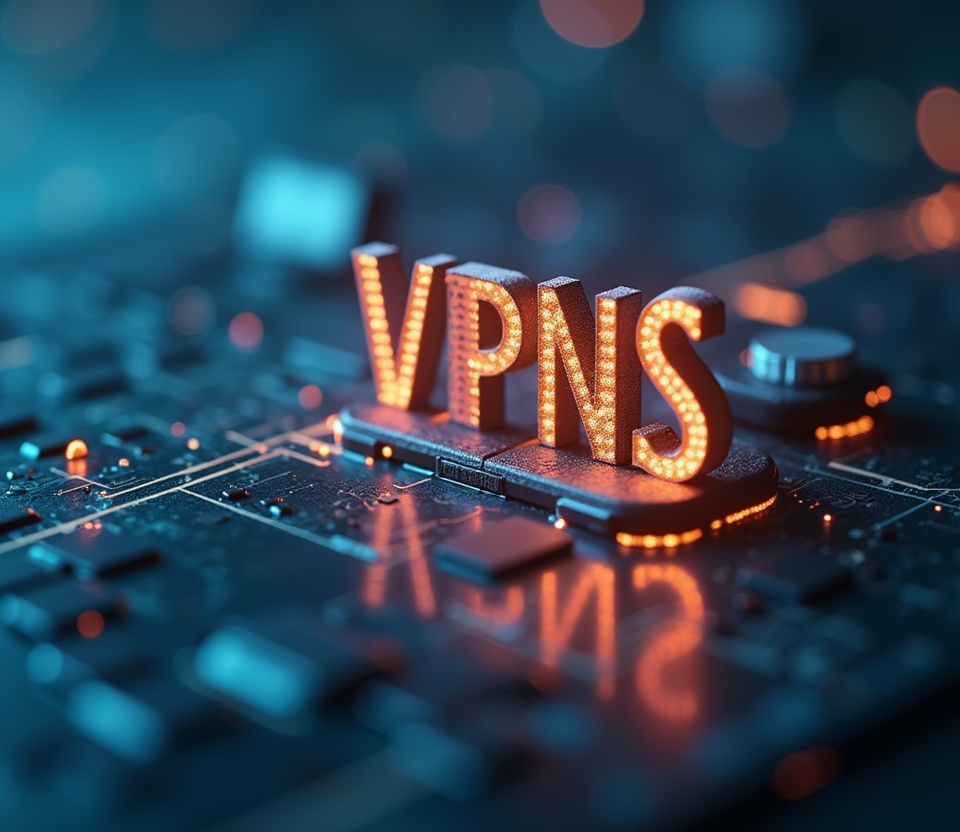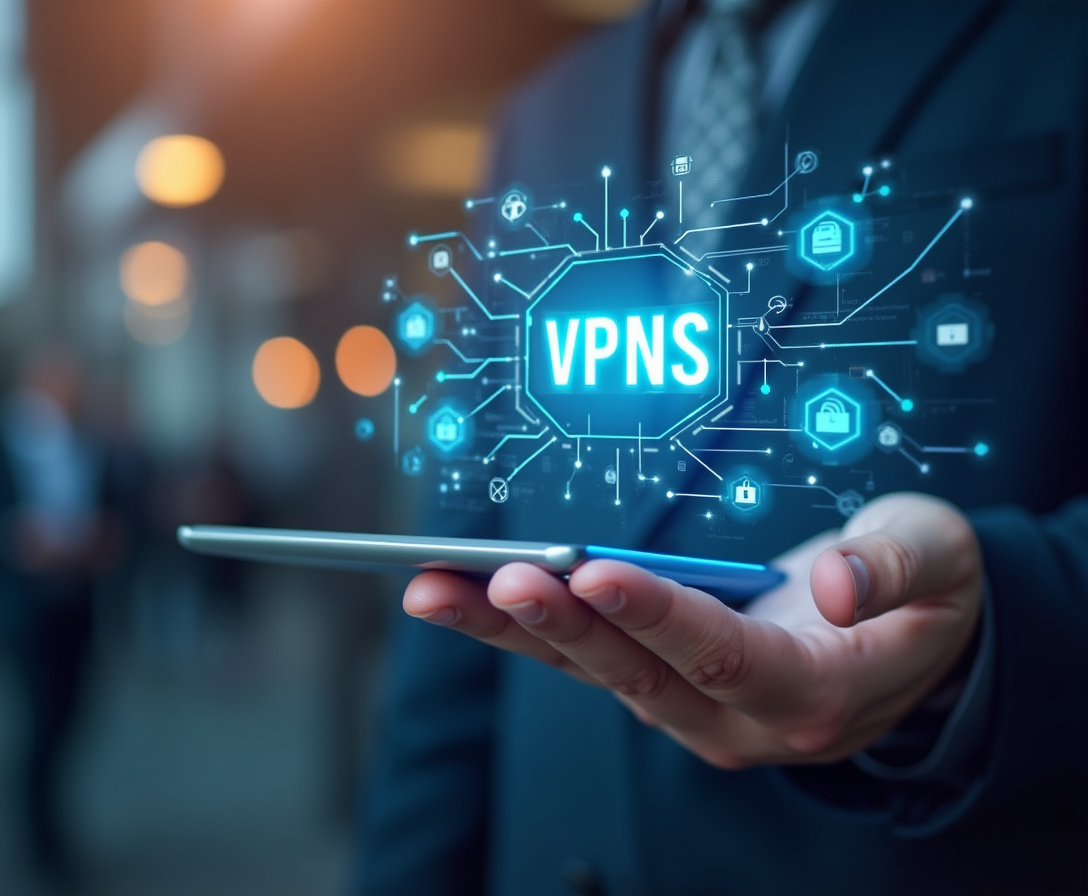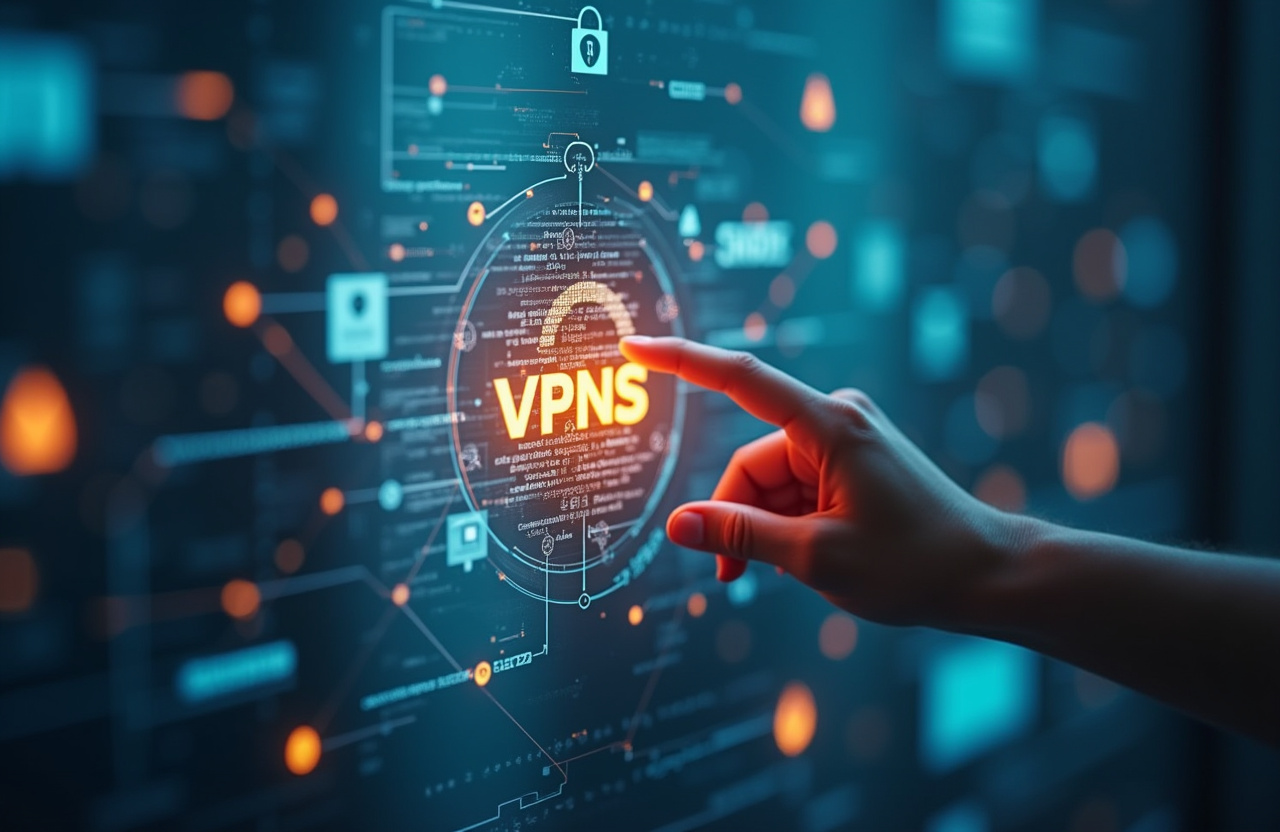VPNs for Tradeshows: Securing Exhibitor and Attendee Data

Table of Contents
Tradeshow Security Risks: Why VPNs are Essential
In today's increasingly interconnected business landscape, tradeshows stand as pivotal hubs for innovation, networking, and forging valuable partnerships. These events attract businesses and professionals from across the globe, creating dynamic environments ripe with opportunities for growth and collaboration. However, this very dynamism also presents significant security challenges, particularly concerning the protection of sensitive data belonging to both exhibitors and attendees.
Tradeshows, by their nature, involve the widespread use of public Wi-Fi networks, the exchange of confidential information, and the potential exposure of proprietary data to competitors and malicious actors. Therefore, prioritizing security at these events is no longer an option, but a critical imperative for ensuring the success and integrity of the entire tradeshow ecosystem. This article delves into the importance of Virtual Private Networks (VPNs) as a robust solution for securing exhibitor and attendee data at tradeshows, exploring how they mitigate risks and provide a safe and productive environment for all participants.
A VPN, in essence, acts as a secure tunnel for your internet traffic, encrypting your data and masking your IP address, effectively safeguarding your online activity from prying eyes. In the context of tradeshows, where participants often rely on inherently vulnerable public Wi-Fi networks, the use of a VPN becomes paramount. These networks are often unsecured, making them easy targets for hackers seeking to intercept sensitive information such as login credentials, financial data, and confidential business communications.
By routing their internet traffic through a VPN server, exhibitors and attendees can effectively shield their data from these threats. The benefits of employing a VPN at tradeshows extend beyond basic data encryption. A properly configured VPN can also prevent man-in-the-middle attacks, where malicious actors intercept data transmitted between a user and a legitimate website or server.
This type of attack can be particularly devastating, as it allows hackers to steal sensitive information without the user even realizing they have been compromised. Furthermore, VPNs can also bypass geographic restrictions, allowing users to access content and resources that may be blocked or unavailable in the tradeshow's location. This can be particularly useful for international attendees who need to access websites or services that are specific to their home country.
For exhibitors, a VPN can provide an invaluable layer of protection for sensitive information such as product designs, marketing strategies, and customer lists. The potential consequences of a data breach for an exhibitor can be severe, including financial losses, reputational damage, and legal liabilities. By using a VPN, exhibitors can significantly reduce the risk of their confidential information falling into the wrong hands.
Attendees also benefit greatly from the use of a VPN, as it protects their personal data, financial information, and communications from potential cyber threats. Whether it's checking email, accessing banking information, or making online purchases, attendees can rest assured that their data is being transmitted securely. In essence, a VPN provides a vital layer of security that ensures a safe and productive tradeshow experience for all participants.
Understanding the specific security challenges faced by exhibitors and attendees is paramount to tailoring VPN usage for maximum protection. Exhibitors, for instance, regularly handle highly confidential data related to their products, pricing, and potential clients, making them prime targets for industrial espionage. Competitors may attempt to infiltrate their networks or intercept their communications to gain a competitive edge.
Attendees, on the other hand, may need to access personal or company email, banking information, or other sensitive data while at the tradeshow, exposing them to risks if they aren't sufficiently protected. By understanding these unique vulnerabilities users can select the appropriate VPN settings and protocols to mitigate the risks. The implementation of VPNs at tradeshows isn't merely a matter of convenience, but a fundamental necessity for maintaining data integrity, protecting competitive edge, and ensuring the trustworthiness of the event itself.
As tradeshows continue to evolve and become more reliant on digital technologies, the importance of VPNs as a foundational security measure will only continue to grow, safeguarding both exhibitors and attendees from the ever-present threat of cyberattacks and ensuring a secure and productive environment for all.
Understanding VPN Functionality for Tradeshow Protection
The effectiveness of a VPN at a tradeshow is directly tied to its proper selection and configuration. Not all VPNs offer the same level of security or performance, and choosing the right one requires careful consideration. Various factors differentiate VPNs, including the strength of encryption, the range of server locations, the specific VPN protocol employed, and the provider's data logging policy.
Understanding these aspects is crucial for selecting a VPN that adequately addresses individual security needs and provides a seamless browsing experience. The level of encryption is arguably the most critical factor, as it determines the strength of the protection applied to transmitted data. Look for VPNs that offer at least AES-256 encryption, which is widely regarded as an industry standard for its robust security.
This standard is incredibly difficult to crack, making it highly effective in protecting against unauthorized access to your data. A diverse selection of server locations is also crucial, offering benefits beyond just security. The availability of numerous servers in different countries enables users to bypass geographic restrictions, accessing content that might otherwise be unavailable in the tradeshow's location.
Furthermore, having servers geographically close to the tradeshow can optimize connection speed and reduce latency, ensuring a smooth and responsive browsing experience. The VPN protocol dictates how data is transported between the device and the VPN server. Common protocols include OpenVPN, IKEv2/IPSec, and WireGuard.
Each protocol has distinct strengths and weaknesses, impacting security, speed, and stability. OpenVPN is often considered one of the most secure and versatile options due to its open-source nature and strong encryption capabilities. IKEv2/IPSec is known for its speed and stability, particularly on mobile devices.
WireGuard is a more recent protocol designed for improved performance and security, but it's still undergoing active development. The logging policy describes what data the VPN provider collects and stores about its users. This is a critical consideration for privacy.
Opt for a VPN provider with a strict "no-logs" policy, meaning they do not track your browsing history, IP address, connection timestamps, or any other personally identifiable information. This ensures that your online activity remains private and cannot be handed over to third parties, even in response to legal requests. Beyond these technical specifications, consider the user-friendliness of the VPN application, the responsiveness of customer support, and the overall reputation of the VPN provider.
A VPN should be easy to install and configure, with a clear and intuitive interface that allows users to connect and disconnect quickly and easily. It should also offer customizable settings to suit individual preferences and security needs. Responsive and helpful customer support is invaluable in case you encounter any technical issues or have questions about the service.
A provider that offers 24/7 support via live chat, email, or phone is ideal. Check online reviews and testimonials to get an idea of the VPN provider's reputation and reliability. Look for providers with a long history of providing reliable and secure service.
Before attending a tradeshow, it's wise to download and install the VPN application on all devices intended for use, including laptops, smartphones, and tablets. Ensure the VPN is properly configured and thoroughly tested before connecting to the tradeshow's Wi-Fi network. Familiarize yourself with the application's settings and features.
Disable any unnecessary features or settings that could potentially compromise your security or privacy. For instance, disable location services if they are not essential. Once connected to the VPN, verify that your IP address has been successfully masked and that your data is being encrypted.
You can use online tools to check your IP address and ensure that it is different from your actual IP address. During the tradeshow, continue to practice safe online habits to enhance your security further. Be cautious about clicking on links or opening attachments from unknown sources, as these could potentially lead to malware infections or phishing attacks.
Avoid entering sensitive information on websites that do not use HTTPS encryption, indicated by a padlock icon in the address bar. Regularly update your device's operating system and applications to patch any security vulnerabilities.
Implementing VPNs: Best Practices for Exhibitors and Attendees
Exhibitor security at tradeshows necessitates a comprehensive, layered approach, where VPNs serve as a crucial foundational element but are complemented by other protective measures. Exhibitors often handle sensitive data, including proprietary customer lists, confidential pricing structures, innovative product blueprints, and insightful market analysis reports. Safeguarding this information is not simply a matter of protecting their competitive advantage; it is also essential for maintaining customer trust and adhering to increasingly stringent data privacy regulations.
Failing to protect this data can result in significant financial losses, lasting reputational damage, and potential legal liabilities. Therefore, exhibitors must prioritize security at every stage of the tradeshow process, from pre-event planning to post-event follow-up. The first step in fortifying exhibitor security is to establish clear, comprehensive security policies and procedures.
These policies should explicitly outline the acceptable use of company devices, the proper handling of sensitive data, both in digital and physical forms, and the procedures for promptly reporting any suspected security incidents. All employees representing the company at the tradeshow, regardless of their roles, should be thoroughly trained on these policies and procedures. This training should cover topics such as password security, phishing awareness, malware prevention, and data encryption best practices.
It is crucial to reinforce the importance of security and to create a culture of vigilance among all team members. Beyond VPNs, exhibitors should consider implementing a range of other security measures tailored to the specific risks they face at tradeshows. Strong, unique passwords are a fundamental requirement.
Encourage the use of password managers to generate and store complex passwords securely. Multi-factor authentication (MFA) should be enabled wherever possible, adding an extra layer of security by requiring a second verification method, such as a code sent to a mobile device. Data encryption, both at rest and in transit, is critical to protect sensitive information from unauthorized access.
Encrypt laptops, hard drives, and other storage devices to prevent data breaches in case of loss or theft. Secure email communications using encryption protocols like S/MIME or PGP. Physical security measures are also essential.
Secure laptops and other valuable equipment with physical locks or tracking devices. Avoid leaving devices unattended in public areas. Be aware of your surroundings and take precautions to prevent theft.
Employ digital strategies, such as regularly scanning devices for malware. Install and maintain up-to-date antivirus software and firewalls on all company devices. Regularly scan for vulnerabilities and patch any security holes promptly.
Limit access to sensitive data to only those employees who need it to perform their jobs. Implement role-based access control to restrict access based on job function. Secure your booth's Wi-Fi network with a strong password and consider using a separate, dedicated network for sensitive transactions.
Educate booth staff on common social engineering tactics and how to avoid falling victim to scams. Before the tradeshow, conduct a thorough risk assessment to identify potential security vulnerabilities and develop a plan to mitigate them. After the tradeshow, conduct a post-event security review to identify any areas for improvement.
Regularly review and update security policies and procedures to keep pace with evolving threats. By taking these comprehensive measures, exhibitors can significantly bolster their security posture at tradeshows, protecting their valuable data and ensuring a safe and successful event. A proactive approach to security is essential for mitigating risks and preventing costly data breaches.
Future of VPNs: Enhancing Tradeshow Security and Privacy
Attendee data protection at tradeshows is equally paramount, as attendees entrust organizers and exhibitors with their personal information, expecting it to be handled responsibly and securely. This data can include names, contact details, job titles, company affiliations, and even dietary preferences or accessibility requirements. Failure to protect this data can lead to privacy violations, identity theft, and reputational damage for both the tradeshow organizers and the participating companies.
Moreover, data breaches can have significant legal and financial consequences, particularly under regulations like GDPR and CCPA. Therefore, a strong emphasis on attendee data protection is not just ethically responsible, but also a legal and business necessity. Attendees themselves play a vital role in safeguarding their own data at tradeshows.
Being proactive about their online security and practicing safe digital habits can significantly reduce their risk of exposure to cyber threats. One of the most critical steps is to utilize a VPN when connecting to public Wi-Fi networks. As previously discussed, VPNs encrypt internet traffic and mask IP addresses, protecting against eavesdropping and man-in-the-middle attacks.
Attendees should select a reputable VPN provider with a strict no-logs policy and ensure that the VPN is properly configured before connecting to the tradeshow's Wi-Fi. In addition to VPNs, attendees should be cautious about the information they share at tradeshows. Be mindful of the data you provide when registering for the event, scanning your badge at exhibitor booths, or participating in surveys or contests.
Only share information that is absolutely necessary and be wary of requests for overly sensitive data. Exercise caution when clicking on links or opening attachments in emails or messages received at the tradeshow. Phishing attacks are common at these events, with malicious actors attempting to trick attendees into divulging their login credentials or other sensitive information.
Verify the sender's identity and the legitimacy of the request before clicking on any links or opening any attachments. Protect your devices with strong passwords or passcodes. Enable biometric authentication, such as fingerprint or facial recognition, if available.
Avoid leaving your devices unattended in public areas and be aware of your surroundings to prevent theft. Regularly update your device's operating system and applications to patch security vulnerabilities. Outdated software can be a gateway for malware and other cyber threats.
Be cautious about connecting USB drives or other external storage devices to your devices at the tradeshow. These devices can be infected with malware. If you must use an external storage device, scan it with antivirus software first.
Review the privacy policies of the tradeshow organizers and the exhibitors whose booths you visit. Understand how they collect, use, and protect your personal data. Ask questions if you have any concerns.
Opt out of any marketing communications or data sharing that you are not comfortable with. Request access to your personal data to verify its accuracy and request corrections if necessary. Report any suspected data breaches or security incidents to the tradeshow organizers or the relevant authorities.
By taking these precautions, attendees can significantly reduce their risk of becoming victims of data breaches or other cybercrimes at tradeshows. Proactive data protection is essential for maintaining privacy, security, and peace of mind. Tradeshow organizers and exhibitors also have a responsibility to protect attendee data.
This includes implementing robust security measures to prevent data breaches, complying with data privacy regulations, and being transparent about their data handling practices. Organizers should provide secure Wi-Fi networks for attendees, implement strong access controls to prevent unauthorized access to attendee data, and encrypt sensitive data both in transit and at rest. They should also conduct regular security audits and vulnerability assessments to identify and address potential security weaknesses.
Exhibitors should train their booth staff on data privacy best practices and ensure that they are aware of their responsibilities under data privacy regulations. They should also limit the amount of data collected from attendees and only collect data that is necessary for legitimate business purposes. By working together, attendees, organizers, and exhibitors can create a tradeshow environment that prioritizes data protection and respects individual privacy rights.
A culture of security and transparency is essential for building trust and fostering long-term relationships.
Event security encompasses a broad range of measures designed to protect attendees, exhibitors, staff, and assets from various threats, both physical and digital. In the context of modern tradeshows, where technology plays an increasingly central role, cybersecurity has become an integral component of overall event security planning. Addressing the digital risks that tradeshows present is no longer a secondary consideration, but a core requirement for ensuring a safe and successful event for all stakeholders.
A comprehensive event security plan should incorporate measures to mitigate potential threats, respond effectively to security incidents, and promote a culture of security awareness among all participants. This plan should be developed in consultation with security experts, law enforcement agencies, and other relevant stakeholders. A crucial element of event security is securing the network infrastructure.
Tradeshow organizers should provide secure Wi-Fi networks for attendees and exhibitors, utilizing strong encryption protocols and implementing access controls to prevent unauthorized access. They should also monitor network traffic for suspicious activity and have incident response plans in place to address any security breaches promptly. Implementing robust access control measures is essential for restricting access to sensitive areas and data.
This includes using badge scanning systems to verify attendee identities and limiting access to restricted areas to authorized personnel only. Physical security measures, such as security guards, surveillance cameras, and perimeter fencing, should also be deployed to protect against physical threats. Cybersecurity awareness training should be provided to all event staff, exhibitors, and attendees.
This training should cover topics such as phishing awareness, password security, and safe Wi-Fi usage. Promoting a culture of security vigilance can significantly reduce the risk of successful cyberattacks. Regular security audits and vulnerability assessments should be conducted to identify and address potential security weaknesses.
These assessments should cover both physical and digital security measures and should be conducted by qualified security professionals. Incident response plans should be developed and tested regularly to ensure that the event organizers are prepared to respond effectively to any security breaches. These plans should outline the steps to be taken in the event of a cyberattack, including containing the breach, eradicating the threat, and recovering any lost data.
Collaboration and information sharing are essential for effective event security. Event organizers should work closely with law enforcement agencies, security vendors, and other relevant stakeholders to share information and coordinate security efforts. Threat intelligence sharing can help to identify and prevent potential attacks before they occur.
Implementing a layered security approach is crucial for creating a robust event security posture. This includes combining physical security measures, cybersecurity measures, and security awareness training to provide comprehensive protection against a wide range of threats. Continuously monitoring and adapting security measures is essential for keeping pace with evolving threats.
Event organizers should stay informed about the latest security threats and trends and adjust their security plans accordingly. Investing in event security is essential for protecting attendees, exhibitors, staff, and assets, and ensuring the success of the event. A strong security posture can enhance the reputation of the event and attract more participants.
Consider partnering with cybersecurity firms or consultants specialized in event security to bolster the overall security and ensure implementation of best practices, which translates to the trustworthiness of the event itself. Furthermore, clear communication about event security is essential for building trust and confidence among attendees and exhibitors.
Stay Updated
Get the latest VPN news, tips, and exclusive deals to your inbox.




